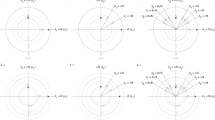Abstract
The dielectric permittivity and conductivity of freshly excised dog skeletal muscle were measured at frequencies between 20 Hz and 1 MHz, with the tissue samples oriented either parallel or perpendicular to the applied electric field. At frequencies below 100 kHz a four-electrode technique was employed; at frequencies above 100 kHz a conventional two-electrode technique was used in conjunction with a commercial admittance bridge. All measurements were performed with the tissue sample at body temperature. Over the entire frequency range of the study, the dielectric properties of the muscle were found to be significantly anisotropic. At audio frequencies, the conductivity of the muscle measured in a direction parallel to the fibre orientation was typically found to be ten times higher than that measured perpendicular to the fibre axis; at frequencies approaching 1 MHz the conductivities measured in both directions approached a common value, near 8 ms cm−1. The dielectric permittivity in both orientations is strongly dependent on frequency. These data are analysed using the suspension equation, and comments are made on the mechanisms that are responsible for the observed properties. In an Appendix these results are related to some of the very early work on the subject.
Similar content being viewed by others
References
Burger, H. C. andvan Dongen, R. (1961) Specific electrical resistance of body tissues.Phys. Med. Biol.,5, 431–447.
Burger, H. C. andvan Milaan, J. B. (1943) Measurements of the specific resistance of the human body to direct current.Act. Med. Scand.,114, 585–607.
Cole, K. C. (1972)Membranes, ions and impulses. Univ. of Calif. Press, Berkeley,5, 5–113.
Ducrot, H., Thomasset, A., Joly, R. et al. (1970) Determination du volume des liquides extracellulaires chez l'homme par la mesure de l'impedance corporelle totale.Press. Med.,78, 2269–2272.
Eyraud, C., Lenoire, J., Fauchou, A. J. et al. (1969) Characterization par methode electrique d'un suspensoide capacitif.C. R. Acad. Sci. (Paris),269D, 744–746.
Geddes, L. A. andDa Costa, C. P. (1973) The specific resistance of canine blood at body temperature.IEEE Trans.,BME-20, 51–53.
Geddes, L. A. andBaker, L. E. (1967) The specific resistance of biological material—a compendium of data for the biomedical engineer and physiologist.Med. & Biol. Eng.,5, 271–293.
Hermann, L. (1871) Ueber eine Wirkung galvanischer Ströme auf Muskeln und Nervern.Pflügers Arch. ges. Physiol.,5, 223–275.
Rush, S., Abildskov, J. A. andMcFee, R. (1963) Resistivity of body tissues at low frequencies.Circ. Res.,12, 40–50.
Sapegno, E. (1930) Über die Impedanz und Kapazität des quergestreiften Muskels in längs und querrichtung.Pflügers Arch. ges. Physiol.,224, 187–211.
Schwan, H. P. (1954) Die elektrischen Eigenschaften von Muskelgewebe bei niederfrequenz.Z. Naturf.,9b, 245–251.
Schwan, H. P. (1957) Electrical properties of tissue and cell suspensions. InAdvances in biological and medical physics, 5,Lawrence, J. H. andTobias, C. A. (Eds.), Academic Press, 147–209.
Schwan, H. P. (1963) Determination of biological impedances. InPhysical techniques in biological research, 6,Nastuk, W. L. (Ed.), Academic Press, 323–406.
Schwan, H. P. andFerris, C. D. (1968) Four-electrode null techniques for impedance measurement with high resolution.Rev. Sci. Inst.,39, 481–485.
Schwan, H. P. andKay, C. F. (1956) Specific resistance of body tissues.Circ. Res.,4, 664–670.
Settle, R. G., Foster, K. R., Epstein, B. R. andMullen, J. (1980) Nutritional assessment: whole body impedance and body fluid compartments.Nutrition and Cancer,2, 72–80.
Stoy, R. D., Foster, K. R. andSchwan, H. P. (1982) Dielectric properties of mammalian tissues from 1 to 100 MHz. A summary of recent data.Phys. Med. Biol.,27, 501–513.
Author information
Authors and Affiliations
Rights and permissions
About this article
Cite this article
Epstein, B.R., Foster, K.R. Anisotropy in the dielectric properties of skeletal muscle. Med. Biol. Eng. Comput. 21, 51–55 (1983). https://doi.org/10.1007/BF02446406
Received:
Accepted:
Issue Date:
DOI: https://doi.org/10.1007/BF02446406




